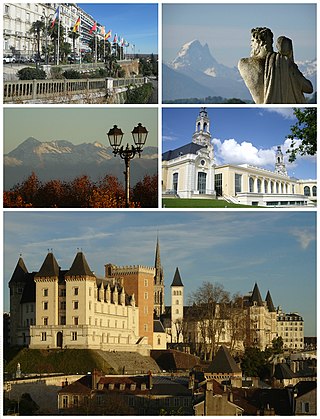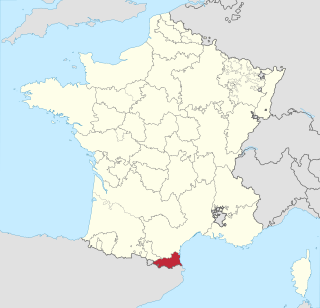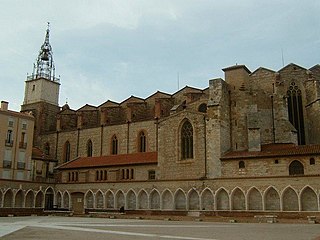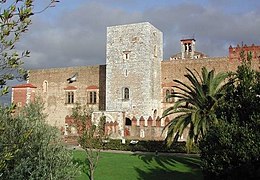An antipope is a person who claims to be Bishop of Rome and leader of the Catholic Church in opposition to the legitimately elected pope. Between the 3rd and mid-15th centuries, antipopes were supported by factions within the Church itself and secular rulers.

The Council of Constance was an ecumenical council of the Catholic Church that was held from 1414 to 1418 in the Bishopric of Constance (Konstanz) in present-day Germany. The council ended the Western Schism by deposing or accepting the resignation of the remaining papal claimants and by electing Pope Martin V. It was the last papal election to take place outside of Italy.

The Avignon Papacy was the period from 1309 to 1376 during which seven successive popes resided in Avignon rather than in Rome. The situation arose from the conflict between the papacy and the French crown, culminating in the death of Pope Boniface VIII after his arrest and maltreatment by Philip IV of France. Following the subsequent death of Pope Benedict XI, Philip forced a deadlocked conclave to elect the French Clement V as pope in 1305. Clement refused to move to Rome, and in 1309 he moved his court to the papal enclave at Avignon, where it remained for the next 67 years. This absence from Rome is sometimes referred to as the "Babylonian captivity of the Papacy".

Perpignan is the prefecture of the Pyrénées-Orientales department in Southern France, in the heart of the plain of Roussillon, at the foot of the Pyrenees a few kilometres from the Mediterranean Sea and the scrublands of the Corbières massif. It is the centre of the Perpignan Méditerranée Métropole metropolitan area.

Pau is a commune overlooking the Pyrenees, and prefecture of the department of Pyrénées-Atlantiques, region of Nouvelle-Aquitaine, France.

Roussillon was a historical province of France that largely corresponded to the County of Roussillon and part of the County of Cerdagne of the former Principality of Catalonia. It is part of the region of Northern Catalonia or French Catalonia, corresponding roughly to the present-day southern French département of Pyrénées-Orientales in the former region of Languedoc-Roussillon.

The Diocese of Urgell is a Latin Church diocese of the Catholic Church in Catalonia (Spain) and Andorra in the historical County of Urgell, with origins in the fifth century AD or possibly earlier. It is based in the region of the historical Catalan County of Urgell, though it has different borders. The seat and Cathedral of the bishop are situated in la Seu d'Urgell town. The state of Andorra is a part of this diocese.

The Western Schism, also known as the Papal Schism, the Great Occidental Schism, or the Schism of 1378, was a split within the Catholic Church lasting from 20 September 1378 to 11 November 1417 in which bishops residing in Rome and Avignon both claimed to be the true pope, and were joined by a third line of Pisan claimants in 1409. The schism was driven by personalities and political allegiances, with the Avignon Papacy being closely associated with the French monarchy.

Pedro Martínez de Luna y Pérez de Gotor, known as el Papa Luna in Spanish and Pope Luna in English, was an Aragonese nobleman who, as Benedict XIII, is considered an antipope by the Catholic Church.

Northern Catalonia, North Catalonia or French Catalonia is the formerly Catalan-speaking and cultural territory ceded to France by Spain through the signing of the Treaty of the Pyrenees in 1659 in exchange of France's effective renunciation on the formal protection that it had given to the recently founded Catalan Republic. The area corresponds roughly to the modern French département of the Pyrénées-Orientales which were historically part of Catalonia since the old County of Barcelona, and lasted during the times of the Crown of Aragon and the Principality of Catalonia until they were given to France by Spain.

Sancho, called the Pacific or the Peaceful, was King of Majorca, Count of Roussillon and Cerdanya, and Lord of Montpellier from 1311 to his death. His 13-year-long reign was markedly undisturbed by turmoil, which earned him his epithets, and is thus often contrasted to the troublesome reigns of his father, James II, and nephew, James III, his predecessor and successor respectively.

The Royal Palace of La Granja de San Ildefonso, known as La Granja, is an early 18th-century palace in the small town of San Ildefonso, located in the hills near Segovia and 80 kilometres (50 mi) north of Madrid, within the Province of Segovia in central Spain.

The Cathedral of Saint John the Baptist is a Roman Catholic cathedral, and a national monument of France, located in the town of Perpignan in Languedoc-Roussillon. It is dedicated to Saint John the Baptist.

The Metropolitan Archdiocese of Montpellier (–Lodève–Béziers–Agde–Saint-Pons-de-Thomières) is a Latin archdiocese of the Catholic Church in south-western France. It was probably created in the 3rd century AD. The current metropolitan archbishop is Pierre-Marie Carré; the immediate past Archbishop Emeritus is Guy Marie Alexandre Thomazeau. On September 16, 2002, as part of the reshuffling of the map of the French ecclesiastical provinces, the diocese of Montpellier ceased to be a suffragan of Avignon and was elevated to archdiocese and metropolitan of a new ecclesiastical province, with the dioceses of Carcassonne, Mende, Nimes and Perpignan–Elne as suffragans.

The Diocese of Perpignan–Elne is a Latin diocese of the Catholic Church in France. The diocese comprises the Department of Pyrénées-Orientales. This see continues the old Diocese of Elne, which was renamed and had its see relocated at Perpignan, in 1601 after a papal bull of Pope Clement VIII. Its territory brought together the Diocese of Elne, part of the Spanish Diocese of Urgel known as French Cerdagne, three cantons of the Diocese of Alet, and two villages of the Diocese of Narbonne.

The Château Royal de Collioure is a massive French royal castle in the town of Collioure, a few kilometers north of the Spanish border in the French département of Pyrénées-Orientales.
The Guitares au Palais is an annual guitar-oriented music festival in the Palace of the Kings of Majorca in Perpignan, Pyrénées-Orientales, France, which began in 2004. The festival focuses on folk, gypsy music, jazz, and flamenco. On the third day there is an additional program with a focus on indie rock related artists. The festival is for free.
The Departmental Council of Pyrénées-Orientales is the deliberative assembly of the Pyrénées-Orientales department in the region of Occitanie, in France. Its 34 conseillers départementaux are elected every 6 years. Each of the 17 cantons of the Pyrénées-Orientales provides two members of this assembly, a woman and a man who are elected together.
Domenec Ram y Lanaja was an aragonese politician and diplomat who was Viceroy of Sicily in 1415–1419, succeeding Prince John of Aragon, later King John II of Aragon.
Hug de Llupià i Bages, was bishop of Tortosa, bishop of Valencia, and a Catalan writer in Latin. He belonged to a noble family from the Roussillon, and he was the brother of Ramon de Llupià. He had a lot of influence and was next to the king most of the time he lived.















